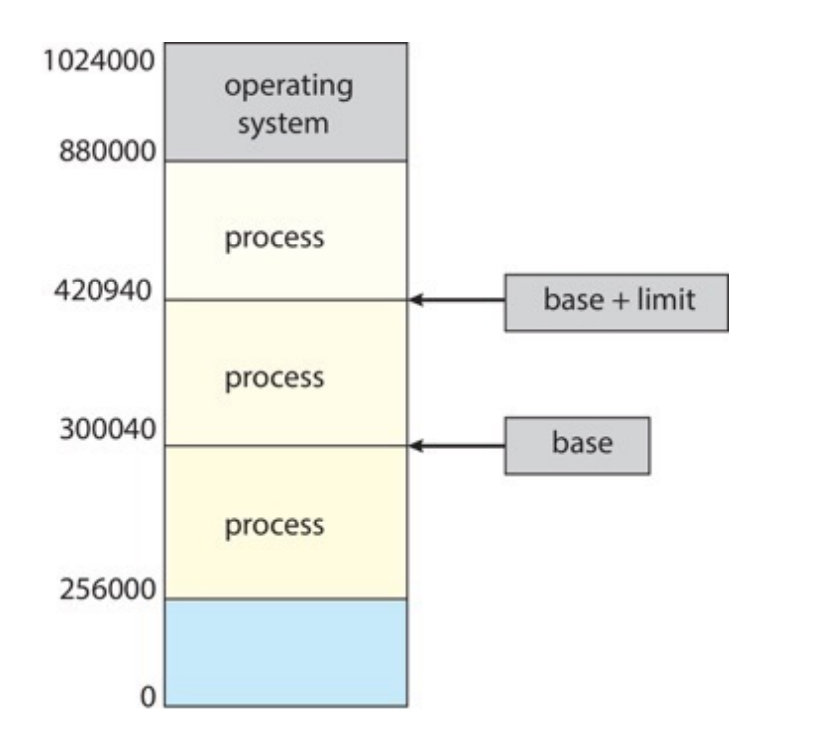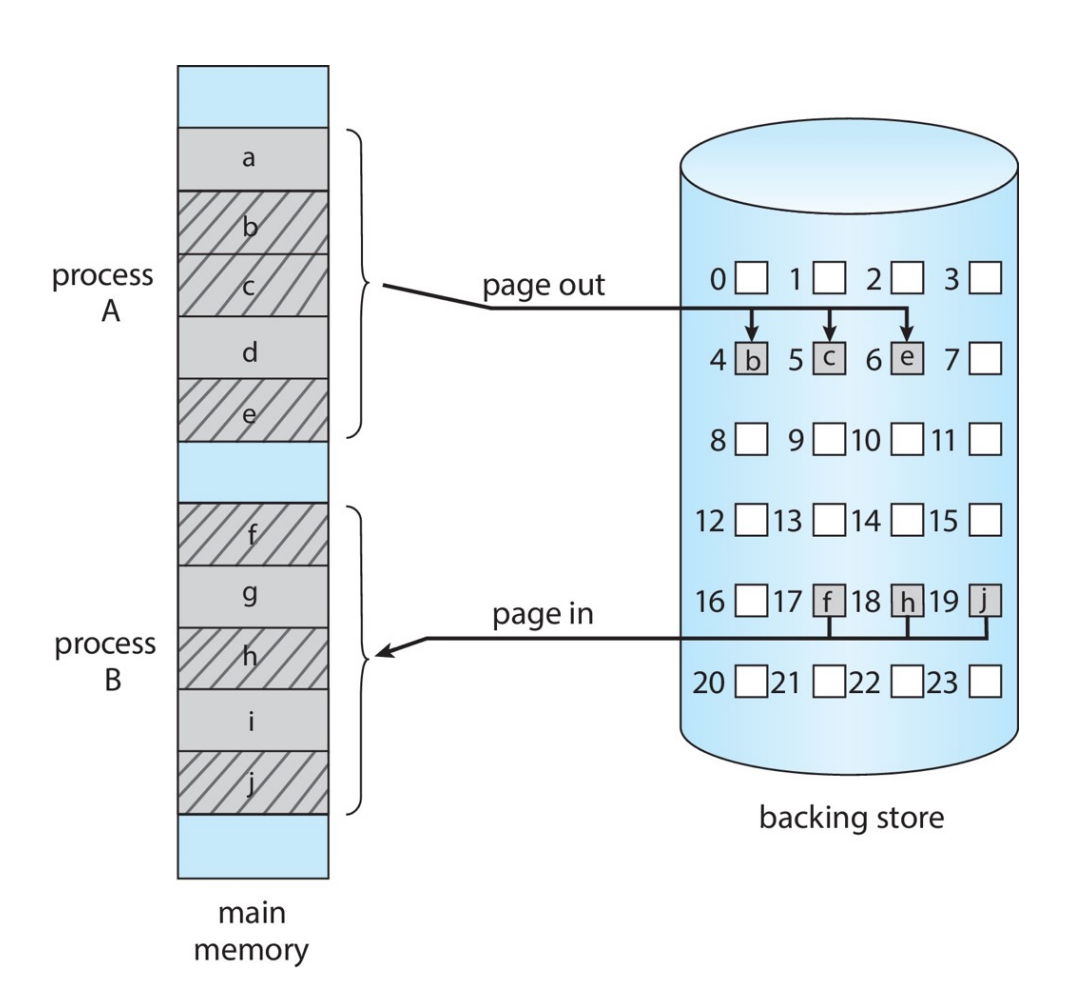Main Memory¶
Program must be brought (from disk) into memory and placed within a process for it to be run.
Main memory and registers are only storage that CPU can access directly.
- Register access is done in one CPU clock (or less)
- Main memory can take many cycles, causing a stall
Protection of memory is required to ensure correct operation.
Partition evolution¶
最开始我们把一个程序加载到物理内存里,只能执行一个 job(如果 job 比物理内存还大就要分治),后来我们有多个进程要同时进行,就使用 partition 分区的方法,不同的分区执行不同的进程。
Partition requirements
- Protection – keep processes from smashing each other
- Fast execution – memory accesses can’t be slowed by protection mechanisms
- Fast context switch – can’t take forever to setup mapping of addresses
Simplest Implementation - Partition¶
Logical address 逻辑地址,由我们自己定义的地址形式。CPU 上使用的地址都是逻辑地址,内存管理看到的是物理地址。CPU 中要将逻辑地址转为物理地址。
Base and Limit registers
- Base added to all addresses
-
Limit checked on all memory references
每次访问时检查是否超过了 Limit,如果是就说明越界了。
-
Loaded by OS at each context switch
每个进程有自己的 base 和 limit 寄存器,每次进程切换时,OS 都会将 base 和 limit 寄存器的值更新为当前进程的值。(线程不需要,因为线程是共享的地址空间)
Example

Hardware Address Protection CPU must check every memory access generated in user mode to be sure it is between base and limit for that user.

CPU 首先发出逻辑地址(即偏移量)随后判断是否超过 limit 范围,随后再加上重定位寄存器(即 base)就得到了真正的物理地址。
Advantages
- Built-in protection provided by Limit
- No physical protection per page or block
- Fast execution
- Addition and limit check at hardware speeds within each instruction
- Fast context switch
- Need only change base and limit registers
- No relocation of program addresses at load time
- All addresses relative to zero
-
Partition can be suspended and moved at any time
-
Process is unaware of change
修改 base 即可移动进程,进程是意识不到的。
-
Expensive for large processes
移动进程需要改 base,还要把旧的内容全部改到新的位置,耗时。
-
Memory Allocation Strategies¶
- Fixed partitions
- Variable partitions
取决于长度是否会变化。
Fixed partitions¶
- Fixed Partitions – divide memory into equal sized pieces (except for OS)
- Degree of multiprogramming = number of partitions
-
Simple policy to implement
-
All processes must fit into partition space.
每个 piece 都可以放一个进程。
-
Find any free partition and load process.
-
size 要切多大?如果切的太小,可能有大进程无法加载进来;如果切的太大,会有内部碎片(因为在一个 partition 内部)。
Internal Fragmentation

Memory allocated may be larger than the requested size
- This size difference is memory internal to a partition, but not being used.
- Sophisticated algorithms are designed to avoid fragmentation.
Variable partitions¶
长度不一致,按需划分。即要给一个进程分配空间时,我们找到比他大的最小的 partition,然后把他放进去。
- Memory is dynamically divided into partitions based on process needs
- More complex management problem
- Need data structures to track free and used memory
- New process allocated memory from hole large enough to fit it
- More complex management problem
- Problem – External Fragmentation
-
Unused memory between partitions too small to be used by any processes
在 partition 之外的空闲空间太小,无法被任何进程使用。
-
Example

How to satisfy a request of size n from a list of free memory blocks?
- first-fit: allocate from the first block that is big enough
- best-fit: allocate from the smallest block that is big enough
- worst-fit: allocate from the largest hole
Variable partitions 可以避免内部碎片,但无论如何总是有外部碎片。
External fragmentation¶
- total amount of free memory space is larger than a request.
- the request cannot be fulfilled because the free memory is not contiguous.
External fragmentation can be reduced by compaction.
- shuffle memory contents to place all free memory in one large block.
- program needs to be relocatable at runtime.
- performance overhead, timing to do this operation.
External Fragmentation

Segmentation¶
利用 partition 的概念实现了 Segmentation 的机制。
认为 text、data、stack 是多个区域,每个区域就可以用一个 partition 来代表它。
-
Logical address consists of a pair:
-
<segment-number, offset>segment-number 表示属于第几组。
-
Offset is the address offset within the segment.
- Segment table where each entry has:
- Base: starting physical address
- Limit: length of segment
-
根据 number 在 table 里找到对应的 base 和 limit,然后加上 offset 就得到了真正的物理地址。

已经有逻辑地址的概念(即地址如何解释是由我们自己定义的),但是没有解决外部碎片的问题。
Address Binding¶
在程序的不同阶段,地址有不同的表现方式:
- source code addresses are usually symbolic. (e.g., variable name)
- compiler binds symbols to relocatable addresses. (e.g., “14 bytes from beginning of this module”)
- linker (or loader) binds relocatable addresses to absolute addresses.
详细可见 CSAPP Chapter 7.
Address binding of instructions and data to memory addresses can happen at three different stages.
- Compile time: If memory location known a priori, absolute code can be generated; must recompile code if starting location changes.
- Load time: Must generate relocatable code if memory location is not known at compile time.
- Execution time: Binding delayed until run time if the process can be moved during its execution from one memory segment to another.

Logical vs. Physical Address¶
-
Logical address – generated by the CPU; also referred to as virtual address.
CPU 看不到物理地址,只用逻辑地址,需要经过特定的部件转化为物理地址。
-
Physical address – address seen by the memory unit.
内存单元只能理解物理地址,它是无法改变的。
逻辑地址对应逻辑地址空间(Logical Address Space),物理地址对应物理地址空间(Physical Address Space)。
Memory-Management Unit¶
Hardware device that at run time maps logical to physical address.

相当于在 CPU 和内存之间做了地址的翻译。
MMU


Paging¶
Contiguous -> Noncontiguous
Physical address space of a process can be noncontiguous; process is allocated physical memory whenever the latter is available.
Fixed 和 Variable 划分都是物理连续的分配,Paging 是把所有内存都变成不连续的,这样空闲的内存不管在哪,都可以分配给进程,避免了外部碎片。
Basic methods
- Divide physical address into fixed-sized blocks called frames(帧)
- Size is power of 2, usually 4KB.
- Divide logical address into blocks of same size called pages(页)
- Keep track of all free frames.
-
To run a program of size N pages, need to find N free frames and load program.
把 N 个帧映射到 N 个页。(页和帧是一样大的)
-
Set up a mapping to translate logical to physical addresses.
-
This mapping is called page table.
存储帧到页的映射,这个数据结构叫页表。
-
Paging has no external fragmentation, but internal fragmentation.
-
worst case internal fragmentation: 1 frame – 1 byte
前面的页都被填满了,只有最后的页才会有碎片。
-
average internal fragmentation: 1 / 2 frame size
页如果小,碎片少,但是映射更多,页表需要更大的空间;反之页如果大,碎片多但映射更少,页表较小。现在页逐渐变大(因为内存变得 cheap)。
Page Table¶
- Page table: Stores the logical page to physical frame mapping
-
Frame table
一个 Bitmap,标记哪些 frame 是空闲的。
页表不存页号(页号用作索引),只存物理帧号。
Example


Address Translation¶
A logical address is divided into:
- page number (p)
- used as an index into a page table
- page table entry contains the corresponding physical frame number
- page offset (d)
- offset within the page/frame
- combined with frame number to get the physical address

首先把 p 拿出来,到页表里读出读出物理帧号,随后和 d 拼接起来就得到了物理地址。

Paging Hardware¶
早期想法:每个页用一组寄存器实现,优势是非常快,但是缺点是寄存器数量有限,无法存储多的页表。(如 32 bit 地址,20 位作为物理页号,会有 \(2^{20}\) 个页)
One big page table maps logical address to physical address
- the page table should be kept in main memory
-
page-table base register (PTBR) points to the page table
PTBR 指向页表的起始地址。(RISC-V 上叫 SATP,ARM 上叫 TTBR,x86 上叫 CR3)
-
page-table length register (PTLR) indicates the size of the page table
这样每次数据/指令访问需要两次内存访问,第一次把页表读出来,第二次再根据页表去读数据。
TLB¶
How to reduce memory accesses caused by page table?
- CPU can cache the translation to avoid one memory access (TLB)
TLB (translation look-aside buffer) caches the address translation.
- TLB hit: if page number is in the TLB, no need to access the page table.
- TLB miss: if page number is not in the TLB, need to replace one TLB entry.
-
TLB usually use a fast-lookup hardware cache called associative memory.
Associative memory: memory that supports parallel search. If page# is in associative memory’s key, return frame# (value) directly.
与页表不同的是,TLB 里存储的既有 page number 又有 frame number,通过比较 page number 来找到对应的 frame number(相当于全相联的 cache)。
-
TLB is usually small, 64 to 1024 entries.
TLB 数量有限,为了覆盖更大的区域,我们也想要把页变得更大。
每个进程有自己的页表,所以我们 context switch 时也要切换页表,要把 TLB 清空。
TLB must be consistent with page table
- Option I: Flush TLB at every context switch, or,
-
Option II: Tag TLB entries with address-space identifier (ASID) that uniquely identifies a process.
通用的全局 entries 不刷掉,把进程独有的 entries 刷掉。
在 MIPS 上 TLB miss 是由 OS 处理的,但是在 RISC-V 上是由硬件处理的。

EAT (Effective Access Time)

Memory Protection¶
到目前为止,页表里放了物理帧号。我们可以以页为粒度放上保护的一些权限(如可读、写、执行),这样就可以实现内存保护。
- Each page table entry has a present (aka. valid) bit
- present: the page has a valid physical frame, thus can be accessed.
- Each page table entry contains some protection bits.
- Any violations of memory protection result in a trap to the kernel.
-
XN: protecting code
-
Segregate areas of memory for use by either storage of processor instructions (code) or for storage of data.
代码无论在 user 还是 kernel 状态下都不能执行。
e.g. Intel: XD(execute disable), AMD: EVP (enhanced virus protection), ARM: XN (execute never)
-
-
PXN: Privileged Execute Never
-
A Permission fault is generated if the processor is executing at EL1(kernel) and attempts to execute an instruction fetched from the corresponding memory region when this PXN bit is 1 (usually user space memory)
在特权模式下不能执行。
-

Page Sharing¶
Paging allows to share memory between processes
- shared memory can be used for inter-process communication
- shared libraries
把 ELF 里不变的部分通过页表映射到不同的进程里。
分页可以允许进程间共享代码,例如同一程序的多个进程可以使用同一份代码,只要这份代码是 reentrant code(or non-self-modifying code:never changes between execution)。
Example
图中所述的是多个进程共享一份库代码(ed)的情况。

Structure of Page Table¶
Page table must be physically contiguous.
如果只有一级的页表,那么页表所占用的内存很大。e.g. 32-bit logical address space and 4KB page size. page table would have 1 million entries (\(2^{32}\) / \(2^{12}\)). If each entry is 4 bytes -> 4 MB of memory for page table alone.
我们需要有方法压缩页表。
- Break up the logical address space into multiple-level of page tables. e.g. two-level page table
- First-level page table contains the frame# for second-level page tables.
Two-Level Paging¶

最坏情况下,如果只访问第一个页和最后一页,那么只用一级页表需要 1K 个页用来放页表(这个页表有 \(2^{20}\) 个条目),但是对于二级页表就只需要 3 个页表(1 个一级和 2 个二级页表),即 3 个页来放页表。
A logical address is divided into:
- a page directory number (first level page table)
- a page table number (2nd level page table)
- a page offset

Page Table in Linux

64-bit Logical Address Space¶
64 bit 下,每个页表 entry 变为 8B,因此一个页可以放 \(2^9=512\) entries。
- 64-bit logical address space requires more levels of paging
- usually not support full 64-bit virtual address space.
- AMD-64 supports 48-bit
- ARM64 supports 39-bit, 48-bit
ARM64
ARM64: 39 bits = 9+9+9+12

页表里存的都是物理地址(物理页号)
页表为什么可以省内存,如果次级页表对应的页都没有被使用,就不需要分配这个页表。
Page Table Quiz

如果页面大小变大(如 64KB),页面 offset 位数变多,前面可用来索引页表的位数就变少了,页表的层级就可能变少。
Hashed Page Tables¶
In hashed page table, virtual page# is hashed into a frame#.
-
Each element contains: page#, frame#, and a pointer to the next element (resolving conflict)
哈希页表的每一个条目除了 page number 和 frame number 以外,还有一个指向有同一哈希值的下一个页表项的指针。这个结构与一般的哈希表是一致的。

Inverted Page Tables¶
Inverted page tables 索引 physical address 而不是 logical address,也就是说,整个系统只有一个页表,并且每个物理内存的 frame 只有一条相应的条目。寻址时,CPU 遍历页表,找到对应的 pid 和 page number,其在页表中所处的位置即为 frame number。

每次要遍历整个页表,效率低下。而且这样不能共享内存(因为一个物理帧只能映射到一个页)。
Swapping¶
- Swapping extends physical memory with backing disks.
- A process can be swapped temporarily out of memory to a backing store.
- The process will be brought back into memory for continued execution.
- Swapping is usually only initiated under memory pressure.
- Context switch time can become very high due to swapping.
用 disk 备份内存(因为内存可能不够用),就把 frame 的值交换到 disk 上,然后把 frame 释放出来。当进程要执行的时候,再把 frame 从 disk 读回来。换回来时不需要相同的物理地址,但是逻辑地址要是一样的。

Swapping with Paging

Takeaway¶
Takeaway
-
- Partition evolution
- Contiguous allocation
- Fixed, variable
- first, best, worst fit
- fragmentation: internal/ external
- Segmentation
- Logical address vs physical address
- Fixed, variable
- Fragmentation
- Internal, external
- MMU: address translation + protection
- Paging
- Page table
- Hierarchical, hashed page table, inverted
- Two-level, three-level, four-level
- For 32 bits and 64 bits architectures
- Page table